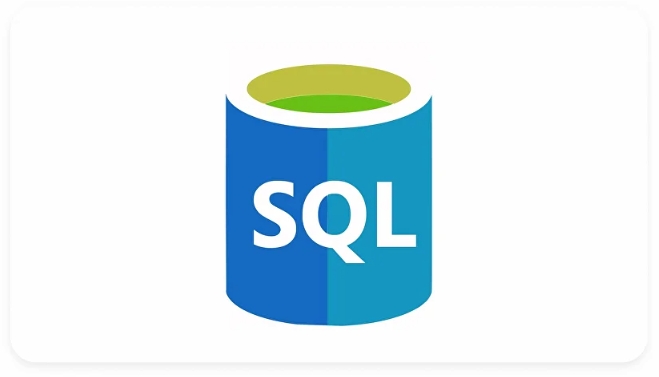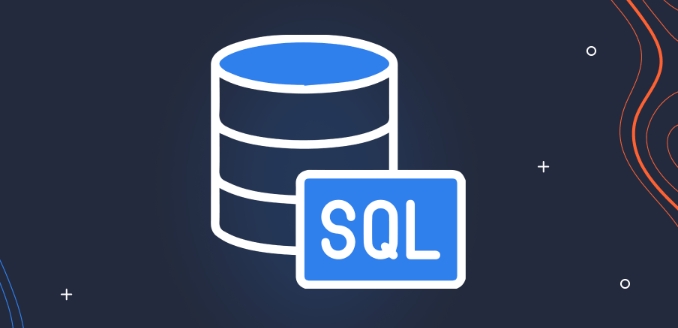Common data types in SQL databases mainly include four categories: 1. Number types, such as INT, BIGINT, SMALLINT, used to store integers, DECIMAL is used for precise decimals, FLOAT and REAL is used for approximation; 2. String types, such as CHAR and VARCHAR are used for fixed-length and variable-length text, TEXT series is used for large text storage, NCHAR and NVARCHAR supports Unicode; 3. Date and time types, including DATE, TIME, DATETIME, TIMESTAMP and YEAR, among which TIMESTAMP is more suitable for processing time zones; 4. Other types such as BOOLEAN are used for boolean values, BLOB is used for binary objects, UUID and JSON are used for unique identification and structured data storage. Regular selection of data types can help improve performance, save storage and ensure data integrity.

When working with SQL databases, understanding common data types is key to designing efficient tables and managing data correctly. Each column in a table must have a defined data type, which determines what kind of values it can store. Here are the most widely used SQL data types and what they're typically used for.

1. Numeric Data Types – For Numbers, Big and Small
SQL provides several data types for storing numbers, and choosing the right one depends on whether you need integers or decimals, and how large the values might be.
-
INTorINTEGER: Used for whole numbers. Usually take up 4 bytes and can store values from around -2 billion to 2 billion. -
BIGINT: When you need larger numbers thanINT, this is your go-to. It uses 8 bytes and can handle numbers up to roughly 9 quintillion. -
SMALLINT: If you're sure the numbers will stay small (like a rating from 1 to 10), this saves space—uses only 2 bytes. -
DECIMAL(p, s)orNUMERIC(p, s): For precision decimal numbers, like money.pis precision (total digits), andsis scale (digits after the decimal). -
FLOATandREAL: For approximately numeric values. These are useful for scientific calculations but not recommended for exact values like currency.
A common mistake is using FLOAT for financial data—this can lead to rounding errors. Instead, DECIMAL is the safer choice.

2. String Data Types – Storing Text of Various Lengths
Text data is handled with string types, and SQL has different options depending on whether the length is fixed or variable.
-
CHAR(n): Fixed-length strings. If you define it asCHAR(10)and store "cat", it still uses 10 characters of space, padded with spaces. -
VARCHAR(n)orTEXT: Variable-length strings. More space-efficient thanCHAR, especially when text length varies. -
TEXT,TINYTEXT,MEDIUMTEXT,LONGTEXT(MySQL specific): Used for large amounts of text without specifying a length. -
NCHARandNVARCHAR: Same asCHARandVARCHARbut for Unicode characters—useful for multilingual content.
For example, if you're storing user names, VARCHAR(50) is usually a good fit. If you're storing long articles, go with TEXT .

3. Date and Time Data Types – Tracking When Things Happen
Handling dates and times properly is cruel in applications like booking systems or logs. SQL has several types for this:
-
DATE: Stores just the date (YYYY-MM-DD). -
TIME: Stores time of day (HH:MM:SS). -
DATETIMEorTIMESTAMP: Stores both date and time. The difference between them varies by database—DATETIMEoften has a larger range, whileTIMESTAMPmight auto-update or convert time zones. -
YEAR: For storing just the year (sometimes used in reports or historical data).
One thing to watch out for: time zones. If your app is global, consider using TIMESTAMP instead of DATETIME since it often handles time zone conversion better.
4. Other Commonly Used Types – Booleans, Binary, and More
Not all data fits neatly into numbers or text. Some data types handle special cases:
-
BOOLEANorBOOL: Stores true/false values. Internally, it's often stored as 1 or 0. -
BLOB: Binary Large Object. Used for storing binary data like images, audio files, or serialized objects. -
UUIDorCHAR(36): For unique identifiers, especially in distributed systems. -
JSON: Some databases like MySQL and PostgreSQL support native JSON types for storing structured data inside a column.
Using BLOB to store images directly in the database is possible, but it can slow things down. A common alternative is to store the file path or URL in the database and keep the actual file on disk or in cloud storage.
That's a quick tour of the most common SQL data types. Choosing the right type for each column helps with performance, storage, and data integrity. It's not overly complicated, but it does require thinking ahead about what kind of data you'll handle.
The above is the detailed content of What are common SQL data types?. For more information, please follow other related articles on the PHP Chinese website!

Hot AI Tools

Undress AI Tool
Undress images for free

Undresser.AI Undress
AI-powered app for creating realistic nude photos

AI Clothes Remover
Online AI tool for removing clothes from photos.

Clothoff.io
AI clothes remover

Video Face Swap
Swap faces in any video effortlessly with our completely free AI face swap tool!

Hot Article

Hot Tools

Notepad++7.3.1
Easy-to-use and free code editor

SublimeText3 Chinese version
Chinese version, very easy to use

Zend Studio 13.0.1
Powerful PHP integrated development environment

Dreamweaver CS6
Visual web development tools

SublimeText3 Mac version
God-level code editing software (SublimeText3)
 How to find columns with a specific name in a SQL database?
Jul 07, 2025 am 02:08 AM
How to find columns with a specific name in a SQL database?
Jul 07, 2025 am 02:08 AM
To find columns with specific names in SQL databases, it can be achieved through system information schema or the database comes with its own metadata table. 1. Use INFORMATION_SCHEMA.COLUMNS query is suitable for most SQL databases, such as MySQL, PostgreSQL and SQLServer, and matches through SELECTTABLE_NAME, COLUMN_NAME and combined with WHERECOLUMN_NAMELIKE or =; 2. Specific databases can query system tables or views, such as SQLServer uses sys.columns to combine sys.tables for JOIN query, PostgreSQL can be used through inf
 How to backup and restore a SQL database
Jul 06, 2025 am 01:04 AM
How to backup and restore a SQL database
Jul 06, 2025 am 01:04 AM
Backing up and restoring SQL databases is a key operation to prevent data loss and system failure. 1. Use SSMS to visually back up the database, select complete and differential backup types and set a secure path; 2. Use T-SQL commands to achieve flexible backups, supporting automation and remote execution; 3. Recovering the database can be completed through SSMS or RESTOREDATABASE commands, and use WITHREPLACE and SINGLE_USER modes if necessary; 4. Pay attention to permission configuration, path access, avoid overwriting the production environment and verifying backup integrity. Mastering these methods can effectively ensure data security and business continuity.
 When to use SQL subqueries versus joins for data retrieval.
Jul 14, 2025 am 02:29 AM
When to use SQL subqueries versus joins for data retrieval.
Jul 14, 2025 am 02:29 AM
Whether to use subqueries or connections depends on the specific scenario. 1. When it is necessary to filter data in advance, subqueries are more effective, such as finding today's order customers; 2. When merging large-scale data sets, the connection efficiency is higher, such as obtaining customers and their recent orders; 3. When writing highly readable logic, the subqueries structure is clearer, such as finding hot-selling products; 4. When performing updates or deleting operations that depend on related data, subqueries are the preferred solution, such as deleting users that have not been logged in for a long time.
 Comparing Different SQL Dialects (e.g., MySQL, PostgreSQL, SQL Server)
Jul 07, 2025 am 02:02 AM
Comparing Different SQL Dialects (e.g., MySQL, PostgreSQL, SQL Server)
Jul 07, 2025 am 02:02 AM
SQLdialectsdifferinsyntaxandfunctionality.1.StringconcatenationusesCONCAT()inMySQL,||orCONCAT()inPostgreSQL,and inSQLServer.2.NULLhandlingemploysIFNULL()inMySQL,ISNULL()inSQLServer,andCOALESCE()commonacrossall.3.Datefunctionsvary:NOW(),DATE_FORMAT()i
 How to find the second highest salary in SQL
Jul 14, 2025 am 02:06 AM
How to find the second highest salary in SQL
Jul 14, 2025 am 02:06 AM
There are three core methods to find the second highest salary: 1. Use LIMIT and OFFSET to skip the maximum salary and get the maximum, which is suitable for small systems; 2. Exclude the maximum value through subqueries and then find MAX, which is highly compatible and suitable for complex queries; 3. Use DENSE_RANK or ROW_NUMBER window function to process parallel rankings, which is highly scalable. In addition, it is necessary to combine IFNULL or COALESCE to deal with the absence of a second-highest salary.
 What is the difference between SQL and NoSQL
Jul 08, 2025 am 01:52 AM
What is the difference between SQL and NoSQL
Jul 08, 2025 am 01:52 AM
The core difference between SQL and NoSQL databases is data structure, scaling method and consistency model. 1. In terms of data structure, SQL uses predefined patterns to store structured data, while NoSQL supports flexible formats such as documents, key values, column families and graphs to process unstructured data; 2. In terms of scalability, SQL usually relies on stronger hardware on vertical expansion, while NoSQL realizes distributed expansion through horizontal expansion; 3. In terms of consistency, SQL follows ACID to ensure strong consistency and is suitable for financial systems, while NoSQL mostly uses BASE models to emphasize availability and final consistency; 4. In terms of query language, SQL provides standardized and powerful query capabilities, while NoSQL query languages ??are diverse but not as mature and unified as SQL.
 What is a composite primary key in SQL?
Jul 08, 2025 am 01:38 AM
What is a composite primary key in SQL?
Jul 08, 2025 am 01:38 AM
AcompositeprimarykeyinSQLisaprimarykeycomposedoftwoormorecolumnsthattogetheruniquelyidentifyeachrow.1.Itisusedwhennosinglecolumncanensurerowuniqueness,suchasinastudent-courseenrollmenttablewherebothStudentIDandCourseIDarerequiredtoformauniquecombinat
 Advantages of Using Common Table Expressions (CTEs) in SQL.
Jul 07, 2025 am 01:46 AM
Advantages of Using Common Table Expressions (CTEs) in SQL.
Jul 07, 2025 am 01:46 AM
The main advantages of CTEs in SQL queries include improving readability, supporting recursive queries, avoiding duplicate subqueries, and enhancing modular and debugging capabilities. 1. Improve readability: By splitting complex queries into multiple independent logical blocks, the structure is clearer; 2. Support recursive queries: The logic is simpler when processing hierarchical data, suitable for deep traversal; 3. Avoid duplicate subqueries: define multiple references at a time, reduce redundancy and improve efficiency; 4. Better modularization and debugging capabilities: Each CTE block can be run and verified separately, making it easier to troubleshoot problems.






